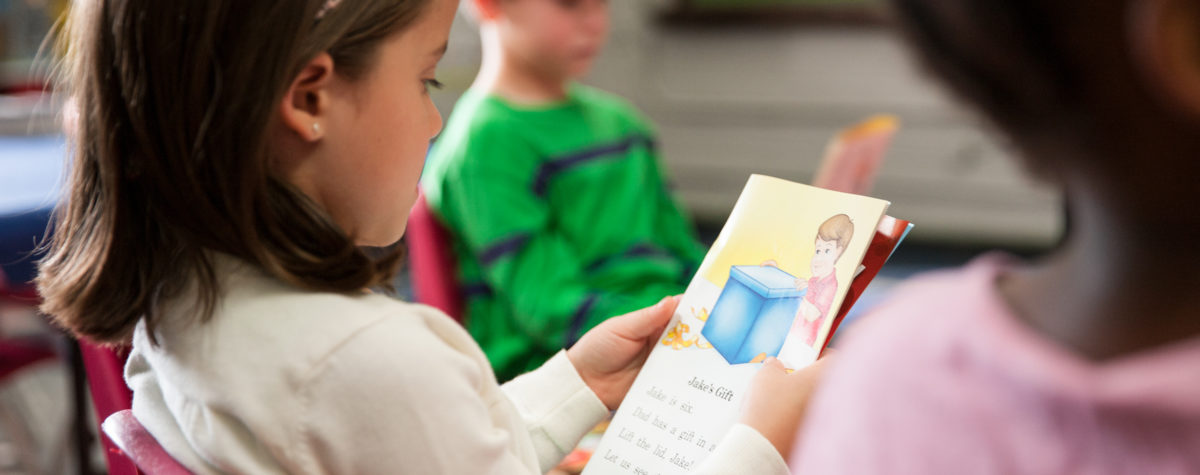Phonics Defined
Phonics is an important method of learning how to read and write. When taught intensive phonics, students learn sound-symbol relationships—the sounds made by individual letters or letter groups. They’ll use this knowledge to decode the words and sound them out.
Why Phonics
The intensive phonics method is often contrasted with the whole-word method, also known as sight-reading. This method teaches children to recognize words as wholes based upon shapes or outlines. Unlike phonics, students are taught to memorize words without paying direct attention to the individual letters and letter groups that make up a word. This leads to an inability to pronounce unfamiliar words, spell correctly, or comprehend what is being read.
With intensive phonics, students are able to read a large number of words quickly and accurately. This improves reading fluency which then builds to reading comprehension. Since they’re not struggling to read the words, they can devote time and energy to develop comprehension of the words they are reading.
The benefits of intensive phonics aren’t limited to reading. When a child learns to read, he has is prepared for a lifetime of learning.
Phonics FAQs
When do children start learning phonics?
This really depends on the curriculum. For Abeka, students are introduced to basic phonics concepts, like learning letters and sounds, as 3-year-olds, prior to officially learning to read.
How long will it take for my students to learn how to read?
This depends on how early and how heavily phonics concepts were introduced to your students. In the Abeka curriculum, phonics concepts are introduced early on. If the student has a solid foundation and a good grasp on letters, sounds, and blends, reading is an easily attainable next step. With the spiral approach to learning, your students will be reading on their own in no time.
How do I make phonics lessons vary so they are not boring?
Reviewing any concept the same way every single time can become boring! That’s why Abeka provides teachers with helpful resources to mix things up, like learning games, colorful flashcards, engaging readers, teaching charts and visuals, and more. Characters like Amber Lamb are also a great way to add some fun to learning phonics concepts.
What do I do if my students are struggling with phonics?
Review, review, review, and review some more. Repetition is the key to learning sounds and blends. Don’t be afraid to go back and spend more time on specific concepts. When you review these concepts, try presenting them in a different way. Try singing, create a game using word cards, or enlist parents to review phonics at home. With enough repetition and practice, your students will be back on track in no time.
How can I become better at teaching phonics?
If you’re reading this blog, you’re already taking a step toward becoming a stronger phonics instructor! As an Abeka teacher, you have access to our Online Learning Library, where you can view hours of free instructional videos taught by our seasoned master teachers. You’ll find helpful videos covering phonics and reading for every grade.
How Abeka Helps You Teach Intensive Phonics
We’ve been helping students learn to read for over 40 years with our intensive phonics approach. With a solid foundation for developing exceptional reading skills, Abeka students begin reading actual words very early.
Our intensive phonics approach is broken down into six simple steps:
- Learn the short vowels and their sounds.
- Learn the consonants and their sounds.
- Learn to blend.
- Learn the one-vowel rule.
- Learn the sounds of long vowels. Learn to sound two-vowel words.
- Learn and apply the special phonics sounds.
We reinforce phonics concepts by implementing character-building stories and seatwork activities that include words with special sounds and sentence comprehension. Our curriculum also carries phonics into all areas of classroom teaching. For example, our kindergarten handwriting books (Writing with Phonics K4 and Writing with Phonics K5) correlate with our basic phonics program to help students learn and review phonics as they practice correct writing formation.
Our easy-to-follow curriculum lesson plans are born from years of accumulated wisdom and experience of Christian educators. They ensure you have everything you need to keep your students on the right track when it comes to learning phonics. We map out each daily lesson and give you the tools you need to maximize your student’s learning experience.
Learn more about our preschool curriculum here.




Sabrina Snyder:
September 3, 2019How do I order the phonics?
Reply to this Comment
Replies to this comment:
Abeka Admin:
October 28, 2019Hello! You can place your order for any Phonics materials online on our website. Follow this link: https://www.abeka.com/Search.aspx#stq=&subject=PHONICS&usedby=STUDENT
This link includes 14 of our student Phonics materials. You can look through them depending on which grade you are wanting to purchase for. You can also give us a call to place your order if you are more comfortable ordering over the phone. Our phone number is 1-877-223-5226, and we are open from 8am-4:45pm CDT.
Reply to this Comment
Tammy Olis:
October 27, 2019I am a 4th grade teacher. I have a group of students that have not had phonics. They are struggling to read and spell. I would like to do an intensive phonics program. Any suggestions how to do this using the ABeka phonics program??
Reply to this Comment
Replies to this comment:
Abeka Admin:
October 28, 2019Hi! We suggest taking a look at our student materials for our Phonics program. There are many items here that you could incorporate into the program you want to begin. The Handbook for Reading is a great tool. Follow this link: https://www.abeka.com/Search.aspx#stq=&subject=PHONICS&usedby=STUDENT
You can also give us a call if you would rather speak to an agent about our Phonics materials. Or number is 1-877-223-5226, and we are open from 8am-4:45pm CDT.
Reply to this Comment